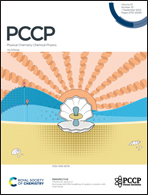Modulating the resistive switching stability of HfO2-based RRAM through Gd doping engineering: DFT+U†
Abstract
Oxide-based resistive random access memory (RRAM) is standing out in both non-volatile memory and the emerging field of neuromorphic computing, with the consequence of increasing performance demands. Rare-earth doping is often used as an effective means for performance modulation. In this work, the modulation mechanism of the resistive switching (RS) behaviors in trivalent rare-earth Gd-doped HfO2-based RRAM has been carefully investigated using first-principles calculations. The results of electronic structure analysis show that Gd doping would lead to a change in the local geometry of the m-HfO2 defect system and would enhance the Coulomb interaction between the atoms around Gd and oxygen vacancy (VO), which may be one of the reasons for the enhanced conductivity of the HfO2-based RRAM after Gd doping. Thermodynamic and kinetic study results indicate that there is a strong interaction between Gd and its surrounding VO defects, and this strong interaction would not only attract more oxygen vacancies (VOs) to be generated near the dopant Gd, but also increase the migration energy barrier of the +2 charged VOs around the Gd doping site, thus suppressing the random generation of VO filaments, which leads to a better uniformity of the switching parameters during the RS process and improves the performance stability of the devices. The results of this work will provide new insights into modulating the RS behaviors and improving the device performance of HfO2-based RRAM through doping engineering.



 Please wait while we load your content...
Please wait while we load your content...